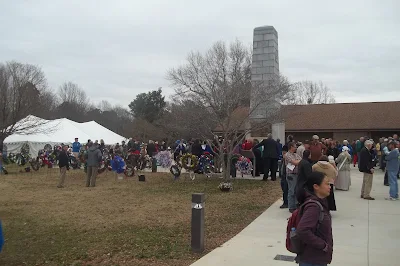 |
| Gathering at the Cowpens National Battlefield Visitors Center around the US Monument for the 236th Anniversary Memorial Service & Celebration of the Battle of Cowpens. |
On Saturday, January 14th, despite a forecast of early morning showers (which never came), this blogger set out for Cherokee County, South Carolina to attend the 236th Anniversary Celebration of the Battle of Cowpens -- one of the more significant battles of the Southern Campaign of the American Revolutionary War.
I arrived about twenty minutes till ten at the Cowpens National Battlefield and made my way to the memorial service sponsored by the South Carolina Sons of the American Revolution (SAR), SC Daughters of the American Revolution, and the SC Children of the American Revolution (CAR).
Several hundred descendants of American Revolutionary War soldiers and veterans from across the United States gathered for what was a lovely memorial service which included SAR and DAR members from both Carolinas, Virginia, Maryland, Delaware, Georgia, and others. This service was followed by an outstanding parade of period uniforms and waving flags as they reenactors and SAR members marched from the visitor's center to the Washington Light Infantry Monument located on the battlefield site itself.
Several hundred descendants of American Revolutionary War soldiers and veterans from across the United States gathered for what was a lovely memorial service which included SAR and DAR members from both Carolinas, Virginia, Maryland, Delaware, Georgia, and others. This service was followed by an outstanding parade of period uniforms and waving flags as they reenactors and SAR members marched from the visitor's center to the Washington Light Infantry Monument located on the battlefield site itself.
 |
| This young Junior Ranger was asked to help preform a very important task by the SAR. |
Following the memorial service, I took the battlefield loop trail and read all of the interesting trail markers telling what took place and where. Being a student of history I've read the accounts of this battle many times over from both sides, but still you never know when you might learn something new and interesting.
Also, it is always a humbling feeling walking the grounds were so many fought and died so long ago. Battlefields have ghosts -- and no I don't necessarily mean in the spectral sense, though some would argue otherwise. I mean that you can feel the sense of importance in certain places, especially when you know what went on there. It is a humbling experience for those who appreciate it and the impact the battle would have on establishing an American nation.
You can look at the ground, largely unchanged from the way it was over two centuries ago (though many of the trees that were there are long gone and replaced by younger ones) and imagine the fear that must have went through the minds of the Carolina militiamen standing behind the trees, or the Continental soldiers from Maryland and Delaware standing in line facing off against British invaders in red and green coats marching toward them, bayonets fixed and pointed. You could even imagine being a young British soldier, marching in perfect formation, but also afraid and fighting so deep inside unfamiliar backcountry territory so far from home.
On the way back I then took in the displays and outstanding presentations put on by the living history reenactors. The following photos show some of the best ones.
 |
| A reenactor wearing the white and blue uniform of the 3rd Continental Light Dragoons. The reenactor in green in the far right wears the uniform of the British Legion Cavalry. |
 |
| A reenactor wearing the blue and red uniform of a Maryland Continental Regiment. |
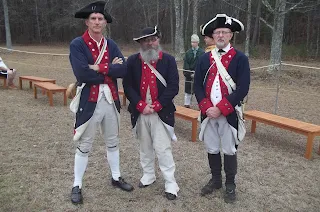 |
| Continental Army reenactors in period attire. |
 |
| Delaware Regiment Continental Army reenactors. |
 |
| Display of period tools and weapons by reenactors of the New Acquisitions District Militia. |
 |
| Pennsylvania & Kentucky Rifles of the type largely used by the Whig (Patriot) militia forces in the South Carolina backcountry during the Southern Campaign of the American Revolutionary War. |
 |
| A reenactor of the 4th Royal Artillery Battalion. Yep, the Royal Artillery did wear dark blue coats rather than red British army coats. |
 |
| Reenactors wearing the green uniforms of the British Legion Infantry. |
 |
| The tartan (Black Watch or Government) trousers worn by this reenactor are historically accurate to the uniform worn by members of the 71st Regiment of Foot (Fraser's Highlanders) during the Battle of Cowpens, though many wore the standard brown winter trousers for British regulars. |
 |
| British Legion & Highlander reenactors mingling. |
Before I bid farewell to the battlefield, I took the time to stop at the US Monument again and read the inscriptions on the granite and the brass plaques detailing the accounts of the battle and the men on both sides who fought there so long ago.
As always I hope that y'all had a good time and enjoyed my photographic account of this event. As always safe travels y'all!




















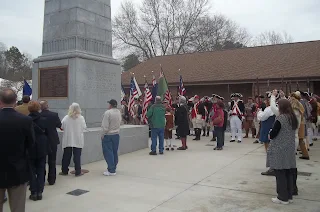

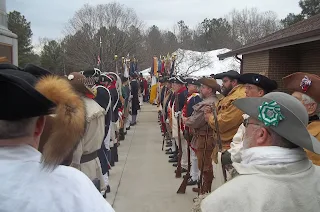
























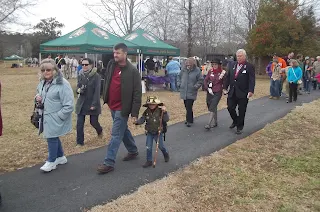



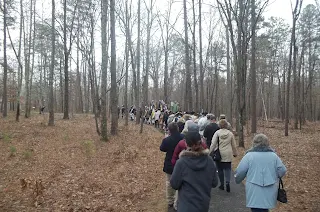
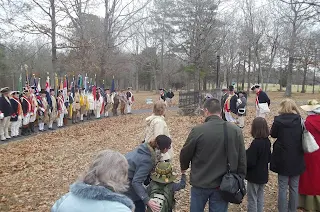












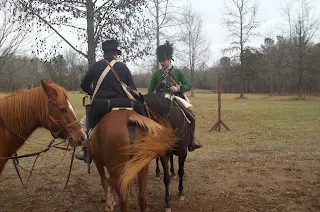















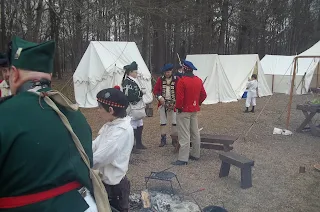














No comments:
Post a Comment